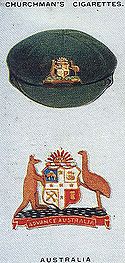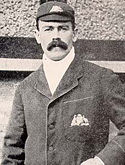
Baggy green
Encyclopedia

Hat
A hat is a head covering. It can be worn for protection against the elements, for ceremonial or religious reasons, for safety, or as a fashion accessory. In the past, hats were an indicator of social status...
of green colour, which has been worn by Australia
Australia
Australia , officially the Commonwealth of Australia, is a country in the Southern Hemisphere comprising the mainland of the Australian continent, the island of Tasmania, and numerous smaller islands in the Indian and Pacific Oceans. It is the world's sixth-largest country by total area...
n Test cricket
Test cricket
Test cricket is the longest form of the sport of cricket. Test matches are played between national representative teams with "Test status", as determined by the International Cricket Council , with four innings played between two teams of 11 players over a period of up to a maximum five days...
ers since around the turn of the twentieth century. The cap was not originally baggy as evidenced by photographs of early players. The cap has long been a symbol of national pride in Australia, and was described by the chief executive of the MCC
Marylebone Cricket Club
Marylebone Cricket Club is a cricket club in London founded in 1787. Its influence and longevity now witness it as a private members' club dedicated to the development of cricket. It owns, and is based at, Lord's Cricket Ground in St John's Wood, London NW8. MCC was formerly the governing body of...
as the "most famous cricket cap in the world".
While respect for the baggy green cap has always been high, it has grown in stature since the 1990s, chiefly due to the efforts of captains Mark Taylor
Mark Taylor (cricketer)
Mark Anthony Taylor, AO is a former Australian cricket player and Test opening batsman from 1988–1999, as well as captain from 1994–1999, succeeding Allan Border...
and Steve Waugh
Steve Waugh
Stephen Rodger "Steve" Waugh, AO is a former Australian cricketer and fraternal twin of cricketer Mark Waugh. A right-handed batsman, he was also a successful medium-pace bowler...
. Waugh regularly expressed his belief that the honouring of the traditions of the game was critical to the success of a team: "To be able to partake of these rituals and traditions has meant you have been awarded the highest honour in Australian cricket — you have been selected to play for your country."

Bill Lawry
William Morris "Bill" Lawry, AM is a former cricketer who played for Victoria and Australia. He captained Australia in 25 Tests, winning nine, losing eight and drawing eight, and led Australia in the inaugural One Day International match, played in 1971...
used the cap while cleaning his pigeon's nest, while Bill Ponsford
Bill Ponsford
William Harold "Bill" Ponsford MBE was an Australian cricketer. Usually playing as an opening batsman, he formed a successful and long-lived partnership opening the batting for Victoria and Australia with Bill Woodfull, his friend and state and national captain...
was known to wear the cap to protect his hair while painting the fence in front of his house. Ian Chappell
Ian Chappell
Ian Michael Chappell is a former cricketer who played for South Australia and Australia. He captained Australia between 1971 and 1975 before taking a central role in the breakaway World Series Cricket organisation...
never kept any of his baggy green caps. In the early 1990s an unofficial practice emerged amongst test players to never replace a baggy green cap, most notably by Steve Waugh. Although there is no official rule against a player obtaining a replacement cap from Cricket Australia
Cricket Australia
Cricket Australia, formerly known as the Australian Cricket Board, is the governing body for professional and amateur cricket in Australia. It was originally formed in 1905 as the Australian Board of Control for International Cricket...
, this almost never occurs, and the increasingly dilapidated state of an aging baggy green cap is a de facto symbol of seniority amongst the players in the team.

Ricky Ponting
Ricky Thomas Ponting , nicknamed Punter, is an Australian cricketer, a former captain of the Australian cricket team between 2004 and 2011 in Test cricket and 2002 and 2011 in One Day International cricket. He is a specialist right-handed batsman, slips and close catching fielder, as well as a very...
changed it again, making the presentation himself rather than using a former player. Another tradition instituted by Taylor (but suggested by Steve Waugh)(and one that has also continued) is the practice of all players wearing the cap during the first session in the field of a Test match, as a symbol of solidarity. Even Shane Warne
Shane Warne
Shane Keith Warne is a former Australian international cricketer widely regarded as one of the greatest bowlers in the history of the game. In 2000, he was selected by a panel of cricket experts as one of the five Wisden Cricketers of the Century, the only specialist bowler selected in the quintet...
, known for his attachment to a floppy sun hat, observed this tradition without question. Modern players seldom wear the baggy green cap while batting, choosing a protective helmet instead, especially when facing faster bowlers.
Baggy green caps can in some cases be prized as valuable sporting memorabilia. The cap worn by Sir Donald Bradman during his final season in 1948 sold in 2003 for A$425,000, and the 1953 cap of Keith Miller
Keith Miller
Keith Ross Miller MBE was an Australian Test cricketer and a Royal Australian Air Force pilot during World War II. Miller is widely regarded as Australia's greatest ever all-rounder. Because of his ability, irreverent manner and good looks he was a crowd favourite...
sold at auction for A$35,000. Even the caps of lesser-known players have fetched figures above A$10,000.
Coat of Arms
Sometimes incorrectly called a "crest", the "achievement" or coat of arms on the Baggy Green cap is a pre-federation symbol representing Australian commercial endeavours of the time: wool-growing, shipping, mining and agriculture.It consists of:
a crest (being a rising sun); over
a torse (or wreath) of red and gold; over
a shield (bearing images of a golden fleece
Golden Fleece
In Greek mythology, the Golden Fleece is the fleece of the gold-haired winged ram, which can be procured in Colchis. It figures in the tale of Jason and his band of Argonauts, who set out on a quest by order of King Pelias for the fleece in order to place Jason rightfully on the throne of Iolcus...
, a sailing ship, a pick-axe and shovel and a garb of wheat, all quartered by a southern cross);
supporters (being a kangaroo and an emu); all over
a motto ("Australia") on a scroll.
Contrary to a common belief, with the exception of the supporters and the motto, this coat of arms is entirely different to the present and any former national coat of arms. Since 1912 the Coat of Arms of Australia
Coat of arms of Australia
The coat of arms of Australia is the official symbol of Australia. The initial coat of arms was granted by King Edward VII on 7 May 1908, and the current version was granted by King George V on 19 September 1912, although the 1908 version continued to be used in some contexts, notably appearing on...
has borne the badges of the six Australian states, enclosed and unified on a shield under a wreath of blue and gold bearing a Commonwealth Star
Commonwealth Star
The Commonwealth Star is a seven-pointed star symbolising the Federation of Australia which came into force on 1 January 1901....
.
The device on the cap is sometimes referred to as Australia's Cricket Coat of Arms, although it has otherwise been abandoned by Cricket Australia. It is not replicated on the protective helmet or any other badged item of clothing worn by the Australian team. These now feature the current logogram of Cricket Australia, being a modern distorted shield with the ubiquitous Southern Cross on a green and gold field of a rising (or perhaps, setting) sun and a wicket casting a shadow on a pitch.

